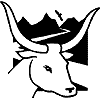HNV Showcases
Chough – the story
Food & home
Rocky coastal grassland with Highlands. Usually, Chough will mate for life and several birds are still breeding in their teens. There life span on Islay exceeds 20 years – the oldest known bird being a 23 year-old female.
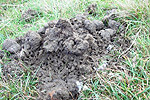 Horse dung. Choughs will forage in dung, feeding on dung beetles and invertebrate larvae. Here horse dung is shown after a “chough attack”.
Horse dung. Choughs will forage in dung, feeding on dung beetles and invertebrate larvae. Here horse dung is shown after a “chough attack”.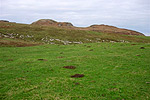 Short-sward Grassland. Choughs largely feed on soil invertebrates. Grazing by domestic livestock helps to provide the range of year-round feeding opportunities that they need.
Short-sward Grassland. Choughs largely feed on soil invertebrates. Grazing by domestic livestock helps to provide the range of year-round feeding opportunities that they need.Short swards and exposed soil facilitate the access to food sources; animal dung enriches the humus layer of the soil. They will even probe the soil surrounding buried animal carcasses.
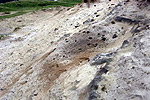 Feeding site in sand dune. Most foraging preferences are associated with the low-intensity rearing of sheep and cattle.
Feeding site in sand dune. Most foraging preferences are associated with the low-intensity rearing of sheep and cattle.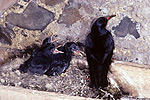 Nestlings with adult. Both nesting and roosting is in coastal and inland caves but some birds also utilise buildings. This behaviour has enabled conservation managers to provide nesting and roosting places specifically for chough.
Nestlings with adult. Both nesting and roosting is in coastal and inland caves but some birds also utilise buildings. This behaviour has enabled conservation managers to provide nesting and roosting places specifically for chough. 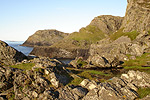 Coastal cliffs as nesting site. Typical Chough nesting area on coastal cliffs.
Coastal cliffs as nesting site. Typical Chough nesting area on coastal cliffs.

